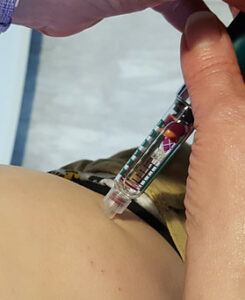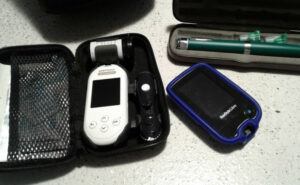Our daughter was immediately faced with wondering how to deal with “Type 1 Diabetes and School” when our four-year-old grandson was diagnosed last June.
He was due to start kindergarten in the fall. How was she going to manage his diabetes with him being at school all day?
It was all so new.
She wasn’t yet confident in managing his diabetes so how was she going to be able to explain to his teacher how to keep him safe all day.
He would have lunch at school which meant someone would have to monitor his blood glucose levels, calculate his carbs eaten at lunch and give him his insulin.
She agonized over this the entire summer while learning to master all this stuff herself.
Of course, it all worked out well since then so let’s take a look at what we learned.
Table of Contents
Diabetes in Children

These days there are increasing numbers of children being diagnosed with Diabetes.
This creates the necessity of special allowances being made at school or sporting events.
Diabetes in children is not often talked about which means most people don’t know how to recognize a problem should it occur or understand what to do.
This puts the child’s life at risk just by doing what other kids do every day, go to school.
The complexities of daily diabetes management can make children feel isolated or excluded from the activities of other children.
Our daughter contacted the school as soon as our grandson was diagnosed because he was registered to attend kindergarten in the fall.
We live in a small rural community and our school is quite small. They were unfamiliar with Type 1 diabetes and were quite concerned about him attending.
It is for this reason that the health care team, parents, and teachers work together to establish a plan that works for each child.
A meeting was set up for late August where the Diabetes Educator clearly went over the diabetes care plan and determined everyone’s role in his individual diabetes care plan.
This plan can change from year to year and even within the same year.
As the child grows and develops their body will respond differently to diabetes causing the care plan to be monitored and adjusted when necessary.
The Law
Under the Canadian Charter of Rights and Freedoms (Section 15 – Equality Rights) every citizen, including people with disabilities, has the right to equal protection and benefit without discrimination. In March 2010, Canada’s Parliament ratified the United Nations Convention on the Rights of Persons with Disabilities. All provinces and territories are now bound by the convention which, among other rights, ensures that “effective individualized support measures are provided in environments that maximize academic and social development, consistent with the goal of full inclusion.”Legally, schools must reasonably accommodate the special needs of children, including students with diabetes.
Consistent with the right to education, schools should also minimize barriers that prevent children from the fullest possible learning experience. The Canadian Diabetes Association has developed Guidelines for the Care of Students Living with Diabetes at School but in most jurisdictions, these recommendations have not been incorporated into policy. The level of support that a child or youth receives depends on where they live, the school they attend, and often their family’s advocacy efforts. For instance, British Columbia recently established provincial standards mandating the administration of insulin and glucagon by trained, unlicensed school personnel. Yet in many other Canadian schools, children have little or no support for blood glucose monitoring or other important diabetes management tasks. Children with diabetes may also be refused entry into daycare or after-school programs.
Safe Diabetes Management in School
Support for the Diabetic student should be individualized and follow the principle of “only as special as necessary“. This will help develop individual dignity, personal independence, and Diabetes self-management appropriate to the student’s age and level of development.

Day to day care of a student with Diabetes does not require medical personnel to be present at the school. Every day, Diabetes Educators are teaching families and caregivers to:
- monitor blood sugars
- give insulin by injection or insulin pump
- recognize and treat hypoglycemia
- supervise meals and snacks
Schools should only be expected to provide basic care and to only perform standard diabetes management tasks. Usually, select individuals within the school will be trained to provide these services when required. Naturally, school employees should be aware they will not be found liable if they take reasonable steps to assist a student with Diabetes in an emergency.
When a school has a diabetic student:
- They require initial education and periodic updates about childhood diabetes.
- There needs to be an “individual care plan” specific to each diabetic student.
- The children need to be informed of which adults at school are their team to go to if they need assistance.
At the beginning of each school year, parents should provide the school with both verbal and written information about the child’s specific diabetes care requirements.
In some instances, a meeting between the child, parents, diabetes team, and school personnel may be required to help clarify requirements and roles.
Usually, the parents are more than capable of providing information and resources without the need for a health care professional.
Hypoglycemia
Severe hypoglycemia can cause loss of consciousness or seizure which makes it crucial to treat while in the mild or moderate stages.
The steps to prevent or treat hypoglycemia are as follows:
- regular meals and snacks and provide adequate time for consumption
- adjust food intake or insulin dose for increased activity ( At school this would be an extra blood sugar check or extra snack before physical activity
- a clean area with handwashing facilities to test blood glucose with a sharps’ container to safely discards test strips and lancets
- supervising young children and knowing how to recognize, treat and prevent hypoglycemia
- ready access to the emergency kit (which contains glucose meter, fast-acting sugar source, extra snacks, etc.)
- older children or teens may need accommodations for tests, quizzes, or exams (extra time) since hypoglycemia is likely to affect test performance even after treatment
A student who is either suspected or confirmed of having hypoglycemia can not be left alone until it has been treated and resolved.
Absenteeism
Support at school is important for every child’s safety as well as being important for their mental health.
Children with diabetes do not have a significantly higher absenteeism rate than other children, except for being absent for regular medical checkups. Parents and children are actively trying to minimize unnecessary school absences.
Some schools use attendance based incentive programs which may unintentionally discriminate against diabetic students. Any time there is a policy that pressures students to forego medical appointments for fear of punishment or missing a class trip, can severely affect their well-being. This is actually discouraging them from taking responsibility for their health which is clearly not in the best interest of the diabetic student.
Conclusion

“Type 1 Diabetes and School” is an important topic to discuss because there are increasing numbers of children being diagnosed with Diabetes. This means schools are having to be resourceful in finding innovative ways to accommodate these students’ medical needs while avoiding needlessly segregating them from the other students.
While they do require some special considerations in that they must be allowed quick access to their emergency kit and enough time to test glucose and make necessary adjustments either with a shot or an extra snack. They are also fully able to participate in class activities and trips.
With the proper education students, parents and teachers can develop a plan that works for each student.
It is important to recognize there is no one size fits all solution. Diabetes affects each person differently and therefore each student care plan will be slightly different.
Our daughter ended up working at the school as a TA to be present to monitor and treat our grandson. This worked out well since she had to drive him because he was denied the use of the school bus because of his diabetes.
We fully realize this is a unique situation and that is why it is so important for the health care team, parents, and school to work together to develop the plan for each student’s care.
Educating the school systems about Type 1 Diabetes is imperative to allow these kids to have as close to normal childhood and education as is possible and as parents and grandparents isn’t that what we really want for our kids.
Thanks for stopping by, please leave your comments or questions below. I will get back to you.

